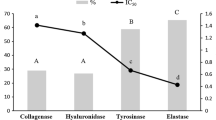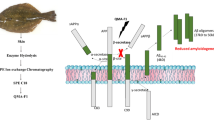Abstract
The objective of this study was to purify and characterize the β-secretase inhibitor from enzymatic hydrolysates of skate skin, for the development of a novel antidementia agent that may be utilized in the drug or functional food industries. β-secretase inhibitory peptide was purified from various enzymatic hydrolysates of skate skin. Among six enzymatic hydrolysates, the Neutrase hydrolysate showed the highest β-secretase inhibitory activity. Consecutive purification of the skate skin hydrolysate using Sephadex G-25 column chromatography and octadecylsilane C18 reversed phase HPLC techniques was used to isolate a potent β-secretase inhibitory peptide composed of 12 amino acids, Gln–Gly–Try–Arg–Pro–Leu–Arg–Gly–Pro–Glu–Phe–Leu (MW: 1,391 Da). The purified peptide had strong β-secretase inhibitory activity, with IC50 value of 24.26 μM, and displayed a non-competitive mode of inhibition. Among the synthesized β-secretase inhibitory peptides, the tetrapeptide Pro–Glu–Phe–Leu had the highest β-secretase inhibitory activity. The result of this study suggests that the β-secretase inhibitory peptide derived from skate skin could be potential candidates to develop nutraceuticals and pharmaceuticals.





Similar content being viewed by others
References
Prince M, Prina M, Guerchet M (2013) World Alzheimer report: an analysis of long-term care for dementia. J Caring. London, England: Alzheimer’s Disease International
Silvestrelli G, Lanari A, Parnetti L, Tomassoni D, Amenta F (2006) Treatment of Alzheimer’s disease: from pharmacology to a better understanding of disease pathophysiology. Mech Ageing Dev 127:148–157
Citron M (2002) Beta-secretase as a target for the treatment of Alzheimer’s disease. J Neurosci Res 70:373–379
Kuhn PH, Wang H, Dislich B, Colombo A, Zeitschel U, Ellwart JW, Kremmer E, Rossner S, Lichtenthaler SF (2010) ADAM10 is the physiologically relevant, constitutive α-secretase of the amyloid precursor protein in primary neurons. EMBO J 29:3020–3032
Selkoe DJ, Schenk D (2003) Alzheimer’s disease: molecular understanding predicts amyloid-based therapeutics. Annu Rev Pharmacol Toxicol 43:545–584
Haass C, Lemere CA, Capell A, Citron M, Seubert P, Schenk D, Lannfelt L, Selkoe DJ (1995) The Swedish mutation causes early onset Alzheimer’s disease by beta-secretase cleavage within the secretory pathway. Nat Med 1:1291–1296
Esch FS, Keim PS, Beattie EC, Blacher RW, Culwell AR, Oltersdorf T, McClure D, Ward PJ (1990) Cleavage of amyloid b peptide during constitutive processing of its precursor. Science 248:1122–1124
Furukawa K, Sopher BL, Rydel RE, Begley JG, Pham DG, Martin GM, Fox M, Mattson MP (1996) Increased activity-regulating and neuroprotective efficacy of alpha-secretase-derived secreted amyloid precursor protein conferred by a C-terminal heparin-binding domain. J Neurochem 67:1882–1896
Meziane H, Dodart JC, Mathis C, Little S, Clemens J, Paul SM, Ungerer A (1998) Memory-enhancing effects of secreted forms of the beta-amyloid precursor protein in normal and amnestic mice. Proc Natl Acad Sci USA 95:12683–12688
Vassar R, Bennett BD, Babu-Khan S, Kahn S, Mendiaz EA, Denis P, Teplow DB, Ross S, Amarante P, Loeloff R, Luo Y, Fisher S, Fuller J, Edenson S, Lile J, Jarosinski MA, Biere AL, Curran E, Burgess T, Louis JC, Collins F, Treanor J, Rogers G, Citron M (1999) Beta-secretase cleavage of Alzheimer’s amyloid precursor protein by the transmembrane aspartic protease BACE. Science 286:735–741
Dorrel S (2000) Untangling Alzheimer’s disease with beta-secretase inhibitors. Drug Discov Today 5:316–317
Ghosh AK, Shin D, Koelsch G, Lin X, Ermolieff J, Tang J (2000) Design of potent inhibitors for human brain memapsin 2 (β-secretase). J Am Chem Soc 122:3522–3523
Turner RT, Koelsch G, Hong L, Castanheira P, Ermolieff J, Ghosh AK (2001) Subsite specificity of memapsin 2 (β-secretase): implications for inhibitor design. Biochem 40:10001–10006
Byun HG, Kim YT, Park PJ, Lin X, Kim SK (2005) Chitooligosaccharides as a novel β-secretase inhibitor. Carbohydr Polym 61:198–202
Je JY, Kim SK (2005) Water-soluble chitosan derivatives as a β-secretase inhibitor. Bioorgan Med Chem 13:6551–6555
Jeon SY, Bae KH, Seong YH, Song SK (2003) Green tea catechins as a β-secretase (β-secretase) inhibitor. Bioorg Med Chem Lett 13:3905–3908
Kwak HM, Jeon SY, Sohng BH, Kim JG, Lee JM, Lee KB (2005) β-secretase (BACE1) inhibitors from pomegranate (Punica granatum) husk. Arch Pharm Res 28:1328–1332
Park IH, Jeon SY, Lee HJ, Kim SI, Song KS (2004) A β-secretase (BACE1) inhibitor hispidin from the mycelial cultures of Phellinus linteus. Planta Med 70:143–146
Lee HJ, Seong YH, Bae KH, Kwon SH, Kwak HM, Nho SK, Kim KA, Hur JM, Lee KB, Kang YH, Song KS (2005) β-secretase (BACE1) inhibitors from Sanguisorbae radix. Arch Pharm Res 28:799–803
Cumming JN, Iserloh U, Kennedy ME (2004) Design and development of β-secretase inhibitors. Curr Opin Drug Dis 7:536–556
Pihlanto-Leppala A (2000) Bioactive peptides derived from bovine whey proteins: opioid and ace-inhibitory. Trends Food Sci Technol 11:347–356
Chen J, Suetsuna K, Yamauchi F (1995) Isolation and characterization of immunostimulative peptides from soybean. J Nutr Biochem 6:310–313
Mendis E, Rajapakse N, Kim SK (2005) Antioxidant properties of a radicals scavenging peptide purified from enzymatically prepared fish skin gelatin hydrolysate. J Agric Food Chem 53:581–587
Suetsuna K, Maekawa K, Chen J (2004) Antihypertensive effects of Undaria pinnatifida (wakame) peptide on blood pressure in spontaneously hypertensive rats. J Nutr Biochem 15:267–272
McLay RN, Pan W, Kastin AJ (2001) Effects of peptides on animal and human behavior. Peptides 22:2181–2255
Kim SY, Park PSW, Rhee KC (1990) Functional properties of proteolytic enzyme modified soy protein isolate. J Agric Food Chem 38:651–656
Johnston JA, Liu WW, Coulson DTR, Todd S, Murphy S, Brennan S (2008) Platelet β-secretase activity is increased in Alzheimer’ disease. Neurobiol Aging 29:661–668
Duncan DB (1955) Multiple range and multiple F-tests. Biometrics 11:1–12
Elias RJ, Kellerby SS, Decker EA (2008) Antioxidant activity of proteins and peptides. Crit Rev Food Sci 48:430–441
Liu Q, Kong B, Xiong YL, Xia XF (2010) Antioxidant activity and functional properties of porcine plasma protein hydrolysate as influenced by the degree of hydrolysis. Food Chem 118:403–410
Hamada Y, Kiso Y (2013) Advances in the identification of β-secretase inhibitors. Expert Opin Drug Dis 8:709–731
Lee DH, Lee DH, Lee JS (2007) Characterization of a new antidementia β-secretase inhibitory peptide from Saccharomyces cerevisiae. Enzyme Microb Technol 42:83–88
Shuto D, Kasai S, Kimura T, Liu P, Hidaka K, Hamada T, Shibakawa S, Hayashi Y, Hattori C, Szabo B, Ishiura S, Kiso Y (2003) KMI–008, a novel β-secretase inhibitor containing a hydroxymethylcarbonylisostere as a transition-state mimic: design and synthesis of substrate-based octapeptides design and synthesis of β-secretase inhibitors: optimization at the P4 and P1′ positions. Bioorg Med Chem Lett 13:4273–4276
Kavon RZ, Doug S, Nan S, Mori T, Huayan H, Deborah J, Jared E (2005) Green tea epigallocatechin-3-gallate (EGCG) modulates amyloid precursor protein cleavage and reduces cerebral amyloidosis in Alzheimer transgenic mice. J Neurosci 25:8807–8814
Wilkinson GN (1961) Statistical estimations in enzyme kinetics. Biochem J 80:324–332
Hong L, Turner RT, Koelsch G, Ghosh AK, Tang J (2002) Memapsin 2 (β-secretase) as a therapeutic target. Biochem Soc T 30:530–534
Ghosh AK, Bilcer G, Harwood C, Kawahama R, Shin D, Hussain KA, Hong L, Loy JA, Nguyen C, Koelsch G, Ermolieff J, Tang J (2001) Structure-based design: structure- based design: potent inhibitors of human brain memapsin 2 ([3-secretase). J Med Chem 44:2865–2868
Bursavich MG, Rich DH (2002) Designing non-peptide peptidomimetics in the 21st century: inhibitors targeting conformational ensembles. J Med Chem 45:541–558
Maillard MC, Hom RK, Benson TE, Moon JB, Mamo S, Bienkowski M, Tomasselli AG, Woods DD, Prince DB, Paddock DJ, Emmons TL, Tucker JA, Dappen MS, Brogley L, Thorsett ED, Jewett N, Sinha S, John V (2007) Design, synthesis, and crystal structure of hydroxyethyl secondary amine-based peptidomimetic inhibitors of human β-secretase. J Med Chem 50:776–781
Byun HG, Kim SK (2001) Purification and characterization of angiotensin I converting enzyme (ACE) inhibitory peptides from Alaska pollack (Theragra chalcogramma) skin. Process Biochem 36:1155–1162
Tung JS, Davis DL, Anderson JP, Walker DE, Mamo S, Jewett N, Hom RK, Sinha S, Thorsett ED, John V (2002) Design of substrate-based inhibitors of human β-secretase. J Med Chem 45:259–262
Turner RT, Koelsch G, Hong L, Castanheira P, Ghosh A, Tang J (2001) Subsite specificity of memapsin 2 (β-Secretase): implications for inhibitor design. Biochemistry 40:10001–10006
Acknowledgments
This research was financially supported by the Ministry of Education, Science Technology (MEST), Gangwon Province, Gangneung City, Gangneung Science Industry Foundation (GSIF) as the R&D Project for Gangneung science park promoting program.
Conflict of interest
None.
Compliance with Ethics Requirements
This article does not contain any studies with human or animal subjects.
Author information
Authors and Affiliations
Corresponding author
Rights and permissions
About this article
Cite this article
Lee, J.K., Li-Chan, E.C.Y. & Byun, HG. Characterization of β-secretase inhibitory peptide purified from skate skin protein hydrolysate. Eur Food Res Technol 240, 129–136 (2015). https://doi.org/10.1007/s00217-014-2314-9
Received:
Revised:
Accepted:
Published:
Issue Date:
DOI: https://doi.org/10.1007/s00217-014-2314-9




